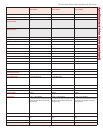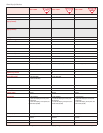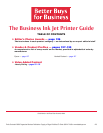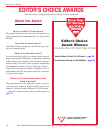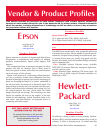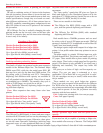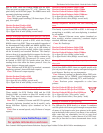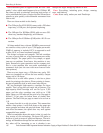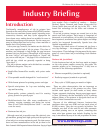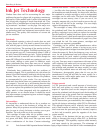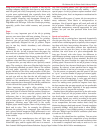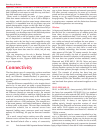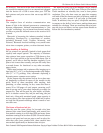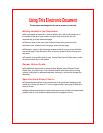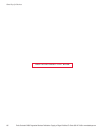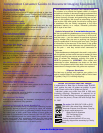
The Business Ink Jet Printer Guide: Industry Briefing
Entire Contents © 2006 Progressive Business Publications. Copying of Pages Prohibited.To Order: 800 247 2185 or www.betterbuys.com 133
using these printer languages is twofold: it frees up the
sending computer faster (you don’t have to wait around
until the print job is fully interpreted), and it allows you
to print more sophisticated jobs, especially those with
enhanced graphics capabilities such as large or small
type, complex diagrams, and documents created in a
page layout program like Quark XPress or Adobe’s
PageMaker and InDesign. Note that PostScript printing,
especially, profits from added memory and processor
speed.
Paper
Paper is a very important part of the ink jet printing
process, even more than with laser printing. You can, as
many do, use regular copy-grade paper for printing.
However, you can get better results by upgrading to a
paper specifically designed for ink jet printers. Papers
vary in two key details: absorbency and reflectance
(brightness).
Absorbency is an important factor because of the
nature of the ink. As ink is sprayed onto the paper, the
best results are produced by a clear, symmetrical dot. If
too much ink is absorbed into the paper, the dot will tend
to spr
ead out,
making a fuzzy dot. This will result in
indistinct colors and fuzzy type and line graphics.
To prevent this, you may want to use a specially coated
paper. The coating is a thin waxy film that helps keep the
ink from being absorbed too much. Most of the vendors
sell such paper, especially for use in printing photo-
graphs. Because of the clarity and precision of the dots,
the printer can lay do
wn an extr
a set of
interpola
ted dots
on each row with no fear that the ink will simply run
together. If you need color images to be archived, you
should use the man
ufacturer’s photo paper only, since
these companies have thoroughly tested the combination
of their ink and their paper for color durability.
More important for regular office printing is the
reflectance, or brightness, of paper. This is a measure of
ho
w much light is reflected from the surface. Rough sur-
faces (such as on most recycled papers) have low
reflectance; that is, they scatter light. Copy paper has
medium r
ef
lectance
.
And high-quality pa
pers (sometimes
sold as laser printer or ink jet printer paper) have high
brightness
,
reflecting more light back to the reader.
Brighter paper means brighter, more vivid printing, both
black and in color. Take, for example, the difference
betw
een the printing on a ne
wspa
per (lo
w r
ef
lectance)
and a glossy fashion magazine (high reflectance) to see
how the same image can look very different when paper
is the v
ariable.
Note that ink jet manufacturers also sell their own
paper suggested for use with their printers. This may
sound lik
e a plo
y
,
and f
or regular office use it is unneces-
s
ary. But for printing photos, you’ll get the best results —
in terms of color accuracy and color stability — using
special paper. As ink jet printers replace standard silver-
halide photo prints, that’s an important consideration for
some users.
Aside from office paper, of course, ink jets can print on
many substrates, from labels to transparencies to
envelopes. Not all special papers will work well with all
ink jet printers. Vendors will be glad to sell you special
papers and transparency material appropriate for your
printers, but you can also purchase them from third
parties.
Speed and resolution
Speeds for ink jet printing have improved dramatically
over the past few years. Even so, buyers should be very
careful when evaluating speeds, especially when compar-
ing them with their laser-printing alternatives. First, the
speed for color laser-class printers has significantly
improved over the past few years, so that you can get
excellent, fast color lasers at a price unimaginable not
long ago. Second, with color lasers, the difference in
speed between printing a page with heavy coverage and a
page with light coverage is pretty minimal. But with ink
jet printers, the more coverage on a page, the slower the
printing speed. Because ink on an ink jet printer is being
put down line by line, the more blank space, the faster the
printing. By contrast, a laser mac
hine has to image the
full drum whether it has lots of coverage or very little.
For this reason, we generally state the speed of ink jets
as “up to”
a cer
tain number of
pages per minute (ppm).
The rated speed given by the manufacturer is usually
based on a low-coverage page. A color page with heavy
co
verage can take considerably longer. While manufac-
turers are making more productive engines these days,
the fact remains that per-page speeds are less predictable
on ink jets than on lasers, especially if the page contains
more than 10 to 15 percent ink coverage.
Another factor that affects speeds has to do with resolu-
tion le
v
els. Nearly all ink jet printers offer a low-resolu-
tion dr
aft mode, a normal mode, and a high-resolution
photo mode
.
Speeds v
ar
y widel
y accor
ding to the mode
selected. When possible, we use the normal-mode figure
in our comparisons, but some vendors don’t clarify the
distinction betw
een dr
aft and normal. Normal resolution
is g
enerally 600dpi, while draft mode is often 300dpi.
From our point of view, 600dpi printing is acceptable for
office use. 300dpi is not the kind of resolution you’d want
to send out of the office.
In theory, this should not be a problem. You can print
in dr
aft mode during the composition of any document
in draft stage and wait to print at normal resolution when
a document is completed and r
ead
y to send out.
In our



